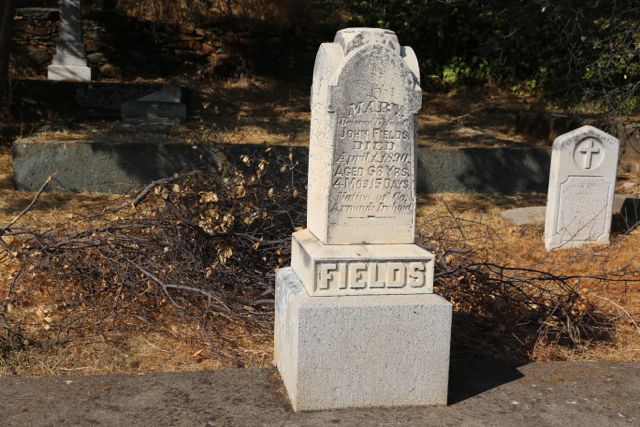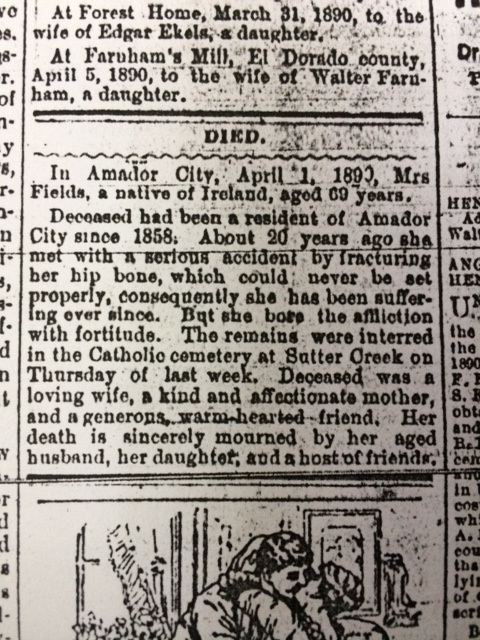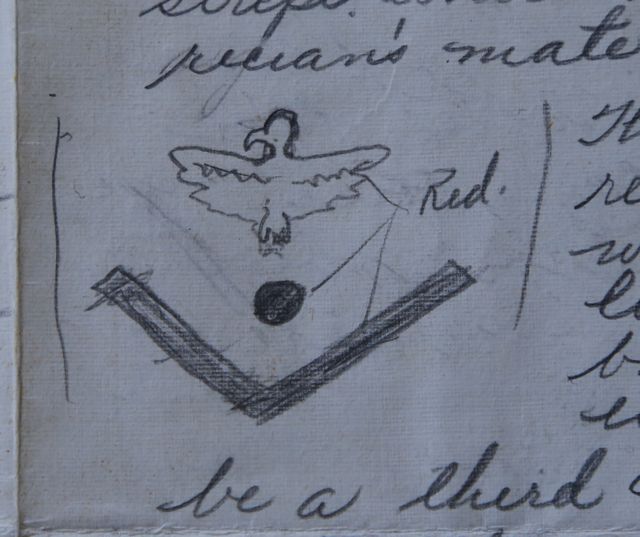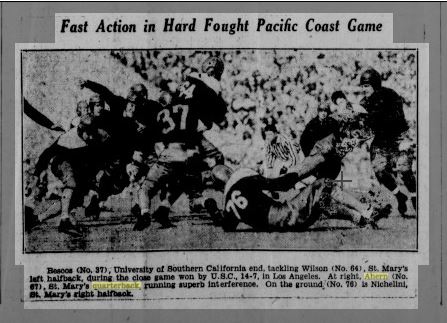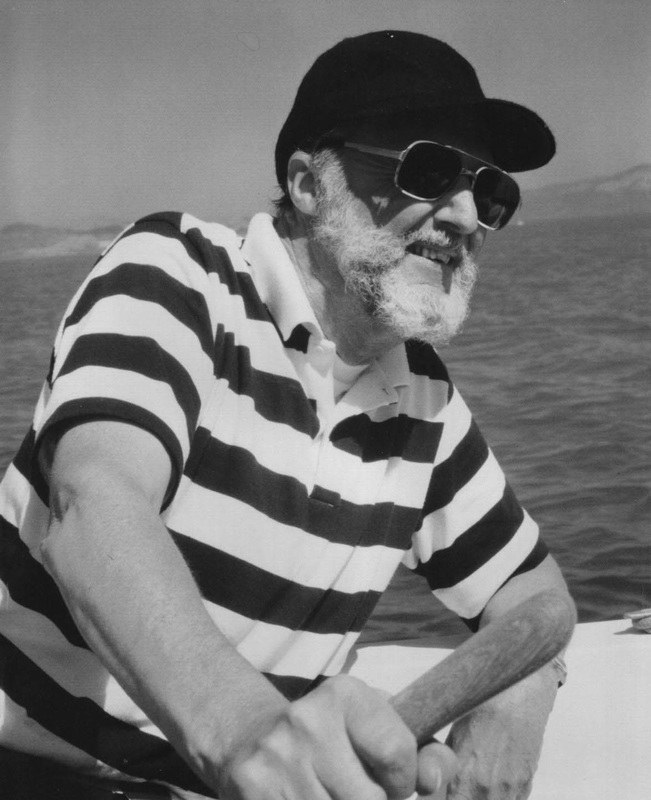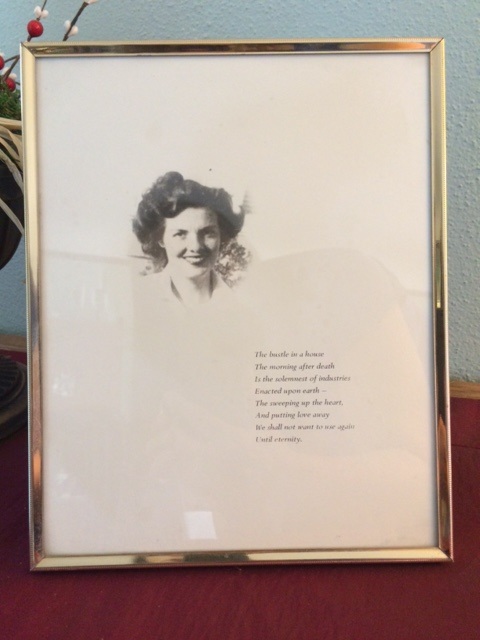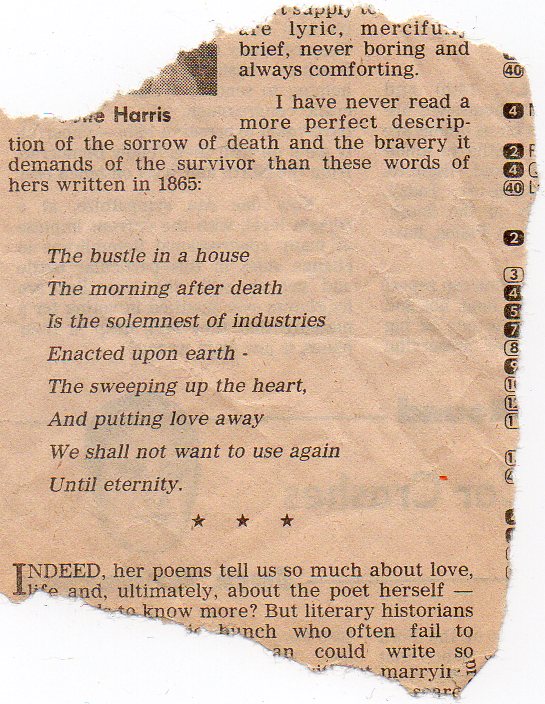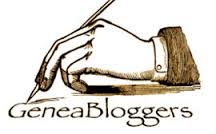|
Newspaper researchers beware – never never never assume anything about newspapers on microfilm!
Several years ago I requested the obituary for my great-great grandmother, Mary Devlin Fields, from the Amador County (California) Public Library. They wrote back indicating that they couldn’t find an obituary in the paper, but there were some missing issues and it might be that the issue with her obituary was lost and never microfilmed. Rats! But not without precedent. Monday I was researching in Jackson, the county seat, and I thought I’d take a look at the microfilm myself. Maybe I could find it. I plopped the microfilm reel labeled “Amador Ledger, Nov 25, 1882 – Mar 30, 1894 (gap 10/27/1883 – 12/1889) into the machine. Mary Fields died 1 April 1890[i], and that wasn’t within the stated microfilm gap, so I scrolled forward to the year 1890. The newspaper, generally four pages, was published once a week on Saturdays. Soon I found myself in the March issues. March 8, March 22 (no March 15!), March 29, May 10. The entire month of April missing! OK, there was another obituary I wanted – Mary’s granddaughter, Mary A Hardy, died 7 June 1890 at age 10 months, 16 days[ii]. Scroll forward. May 17. May 31… July 26. Really??!! Did my people purposefully die on just those dates where the newspapers would disappear??!!! Grrrr….. I pressed the rewind button on the microfilm reader. Nothing happened. Forward button worked. Backward button didn't. Great! And since it’s an electric winding mechanism, there wasn't even a crank to turn to rewind the microfilm. I got to hand turn the microfilm reel. Turn turn turn turn turn. Turn turn turn turn turn. Hoping against hope that the label on the box was wrong, I thought maybe, just maybe, I could at least find a birth announcement for little Mary A Hardy, sometime in July of 1889, After a few more turns I began to read the dates on the newspapers. May 17, 1890. May 10, 1890. May 3, 1890… Wait! What? I’ve been rewinding this microfilm and I’m still in 1890? More hand rewinding. April 26. April 19. April 12, 1890. And there I found it… “Died. In Amador City, April 1, 1890. Mrs. Fields, a native of Ireland, aged 69 years. Deceased had been a resident of Amador City since 1858. About 20 years ago she met with a serious accident by fracturing her hip bone, which could never be set properly, consequently she has been suffering ever since. But she bore the affliction with fortitude. The remains were interred in the Catholic cemetery at Sutter Creek on Thursday of last week. Deceased was a loving wife, a kind and affectionate mother, and a generous, warm-hearted friend. Her death is sincerely mourned by her aged husband, her daughter, and a host of friends.”[iii] Backward and forward again, I found neither birth nor death notice for Mary A. Hardy. Those issues seem really truly missing. But thank goodness for that broken button on the microfilm reader, for making me rewind slowly! Research takeaways?
[i] Sutter Creek Catholic Cemetery (Sutter Creek, Amador, California), Mary Fields momumental inscription, ready my M. Roddy, 28 August 2016. Monument is standing marker with four sides, three of which are inscribed.Mary Fields is on the side facing the burial plot. [ii] Sutter Creek Catholic Cemetery (Sutter Creek, Amador, California), Mary Devlin Fields momumental inscription, ready my M. Roddy, 28 August 2016. Mary A. Hardy’s inscription is on the left hand side of the same marker as Mary Fields. [iii] “Died,” Amador Ledger, (Jackson, Amador, California), 12 April 1890, p. 2, col. 4 California), 12 April 1890, p. 2, col. 4
0 Comments
I'm in California now, doing a little genealogy research and visiting family. I've been spending some time with my cousins and my Auntie Wilma, who was married to my mom's brother, Warren. Wilma has a collection of letters Warren wrote to his family during World War II. A couple of years ago when I visited, she pulled out a bag of letters and I set to work putting them in chronological order.
The letter I post here was written close to today's date 74 years ago. Warren's birthday would be later this week. I miss him very much. He was a wonderful father, son, brother, and uncle. August 24 [1942] Dear Rosie and Geo,[i] By the time this letter reaches you Geo will have probably left for San Diego but I’ll include his name in case he is still there. I know how bad you must feel to see him go and how bad he must feel to leave. It was better however, to join the Navy now than let the Army get him. Send me his address and I’ll write him as soon as I get it. I don’t know what school the selection officer will give him but I sure wish he could come back to Detroit and study with me for electricians mate. Four other fellow and myself left San Diego for Detroit and we certainly had a lot of fun I’ve never had better food than that we got on the train. We were served in the diner, allowed a buck a meal. From the following paragraphs you might assume that there were only four of us on the train but it was full of sailors from about ten other companies, some going to Rhode Island to gunnery school and some to Radio school at Indianapolis. Every station we pulled in to all of the sailors including yours truly would be out talking to the girls. Speaking of girls, there are sure some honeys here and they’re certainly friendly. A lot of the boys have already been invited by them to their homes for dinner. For some reason the whole town has a friendly attitude towards sailors, we never have to ride the streetcar although they are free. We just step off the curb and within two minutes someone will give us a lift. It doesn’t cost a sailor a cent to get drunk, the men here will set him up as many as he wants. We can get our meals and sleep at the U.S.O. free. The show rates are cut in half for us. As you know we are studying for electricians mate third class. We started today and these are our subjects for the first eight weeks: General Instruction Electrical Theory Mathematics, Wiring Shop tool Instruction, Electrical Machine Lab. I’m sure going to try to make the grade, if I make a 3.5 average which corresponds to about 87% I’ll get a crow and one stripe which signifies electrician’s mate third class. [at this point in the letter there is a hand drawn illustration of the Navy logo he describes.] This has a faint resemblance to what it looks like the round ball means electrician. I would be a third class petty officer. I would sure be proud to bring it home and show Dad. I would like Vernice[ii] to see it too. I haven’t got an answer from her as yet but maybe they have it down to San Diego and they haven’t forwarded it. I guess I’d better write her again soon and give her my new address. We have liberty here every weekend from noon Saturday until midnight Sunday. I had a swell time here on my first liberty. Our quarters are pretty cramped here as at Kidd. There are four companies here in a comparatively small building. The bunks are three high, the firs one is about 8” off the floor and the top about 6’ off the floor. I’ve got a bottom one so if I fall out of bed I won’t break my neck. The weather here is certainly queer. When we first arrived it was so hot we slept without blankets and the last few nights have been very cold. I wish it would make up its mind so I could get a good sleep. Well, Sis, it’s nine o’clock and I want this letter mailed tonight. I’d sent it air mail but I haven’t a stamp and won’t be able to get one until tomorrow. If George is still there I wish him all of the luck in the world and hope to see him soon. Write soon, Sis as I would like to know what you two are doing and how everything is going in general. Give my love to Mrs. Powers.[iii] Say hullo to everyone. Your brother, Warren [i] Letter written to his sister, Rosemary Brown Hartman and her husband, George Hartman who was a very good friend to Warren. They had played soccer together. [ii] Might have been a girlfriend of Warren’s in San Francisco. [iii] Mrs. Powers is George’s grandmother. She raised George and was more like a mother to him than a grandmother. Your life is much more than two or three dates. I don’t remember my birth. I’m fairly certain I won’t remember my death. The only one of the “Big Three,” BMD (Birth Marriage Death) events that I’ll ever have much recollection of is the “M,” that day almost 33 years ago that I married my wonderful Monchers. (Why Monchers? As a newlywed, when I’d hear him come home from work I’d run to the front door to greet my “Mon Cheri.” The name just evolved from there.)
Your ancestors had those three important days in their lives as well. But in an 80 year life holds more than 29,000 days. If we try to reduce our ancestors’ stories to only three of those days, we miss so much of what made them who they were. If I only remembered my wedding, I’d have missed all those moments big and small that have occupied our lives – not one but two broken water pipes; sitting on the deck sipping gin and tonics and reading the paper together; a walk around the block as our 18-month-old son toddled ahead and our German Shepherd ran back and forth, circling his “herd” to keep them together; picking blackberries at the park and coming home and making jam together. Those day to day things are “life.” Make note of what you do. Dress. Eat. Work. Relax. Commute. Chores. Hygiene. If you do it, you ancestors did, too. Think about how they might have done things. Did they grow their own food? Hunt for game? Buy it in a market? How did they pay for it? How often did they shop? How far did they have to travel to reach a market? How did they get there? How did they prepare the food? How did they store it? How did they dress themselves? Who made the clothes? What were they made from? How many clothes did they have? How did they maintain their clothes? How did they launder them? How often did they launder them? Where did they work? Was it dangerous? How did they get there? Was it the same thing every day or did their job vary with the seasons? Did they have job security? How were they paid? How much? How often? Did they go to school? For how many years? Were girls educated or only boys? What ages were educated together – a one-room or two-room schoolhouse or a different classroom for every grade? How did they relax? What kind of games might they have played? What books might they have read? Were dancing or music part of their entertainment or relaxation? Were sports? Before you write your family history, ask yourselves all these questions and more. Then read read read to find the answers. Read old newspapers. Read magazines from back in the day. Read occupational guidebooks written at your ancestors’ times – how to farm, how to keep a home, how to raise children. The more day-to-day details you can include in your family history, the more real it will seem to your reader. Because day-to-day life is real living. For additional resources here are a few sites:: Cornell University HEARTH – Home Economics Archive – Research Tradition History - http://hearth.library.cornell.edu/ Cornell University Core Historical Literature of Agriculture - http://chla.library.cornell.edu/ Genwriters - http://genwriters.com/ - great questions (and some answers) to get you thinking about your ancestors’ world If you have some resources you use for learning about your ancestors’ lives, please share. I’d love to hear about your favorites! For Christmas of 1999, I sent my father a tape recorder and a list of questions. (Was this a gift for him or for me? I’ll let you be the judge of that.) But over the next few months and years, Dad answered the questions and I transcribed his words. I’m periodically posting some of his thoughts.
This section has to do with when the family got a radio. Dad talks about listening to football on the radio, and tracking the game. As someone who grew up in the TV generation, I appreciate the resourcefulness of radio sports fans. “We got a radio ourselves. We had a radio in the living room and we began to listen to things. Football, of course, was important. There were no professional teams. They did not come until 1945, after the war. But we did have colleges. Cal played Stanford. USF played St. Mary’s. St. Mary’s and Santa Clara were always a big deal. And they played on Saturdays and on Sundays. “And we would listen to our radio and put out a chart on the floor of the lined football field. 10 yards., and keep a little button and watch the ball go up and down the field, depending on whether St. Mary’s had made some yards or didn’t make some yards. “Football rules were different in those days, too. There were no center stripes for putting the ball in play. If you… wherever you were tackled, that’s where you put it. If you were tackled three yards from the sidelines, you’d start the next play three yards from the sidelines. If you ran out of bounds, you started the play one yard inbounds. So that sometimes the center was on the end and all the rest of the line was sticking over toward the center of the field. Most of those games were played 6-0, 6-7, or 13-6. You never heard of a game going over 20 points.” Tom Kircher, recorded sometime in 2000. I selected this particular section for a couple of reasons. I presented a session at the Northwest Genealogy Conference last week, “Telling Their Story When They Left No Stories.” One of the points I make is to think about everything in your life – work, clothing, entertainment, sports, religion, politics and more. If you do it or think about it, your ancestors probably did, too. As fall approaches teams both professional and amateur are gearing up for a new season on the gridiron. This memory from my dad speaks to one aspect of his life. Did your ancestors have any interaction with athletics, either as a player or fan? I’m on a research road trip. My husband found the recordings of my dad on his computer and burned some of them to CD for us to listen to in the car. Dad passed away eight years ago, but it sure is a treat to get to hear him tell me a story in his own voice. And I so love my husband for wanting to listen, too. As a bit of an aside, when Dad talks about football in this piece, he mentions St. Mary’s a couple of times. I wish I had followed up with Dad about why St. Mary’s seemed particularly notable. It wasn’t his alma mater. But it may have been his family particularly followed St. Mary’s because his mother’s cousin, Jim “Sid” Ahern, played for the Gaels. I can’t help but wonder if the game against USC was one Dad had listened to and tracked with his grid and button. Go Gaels! 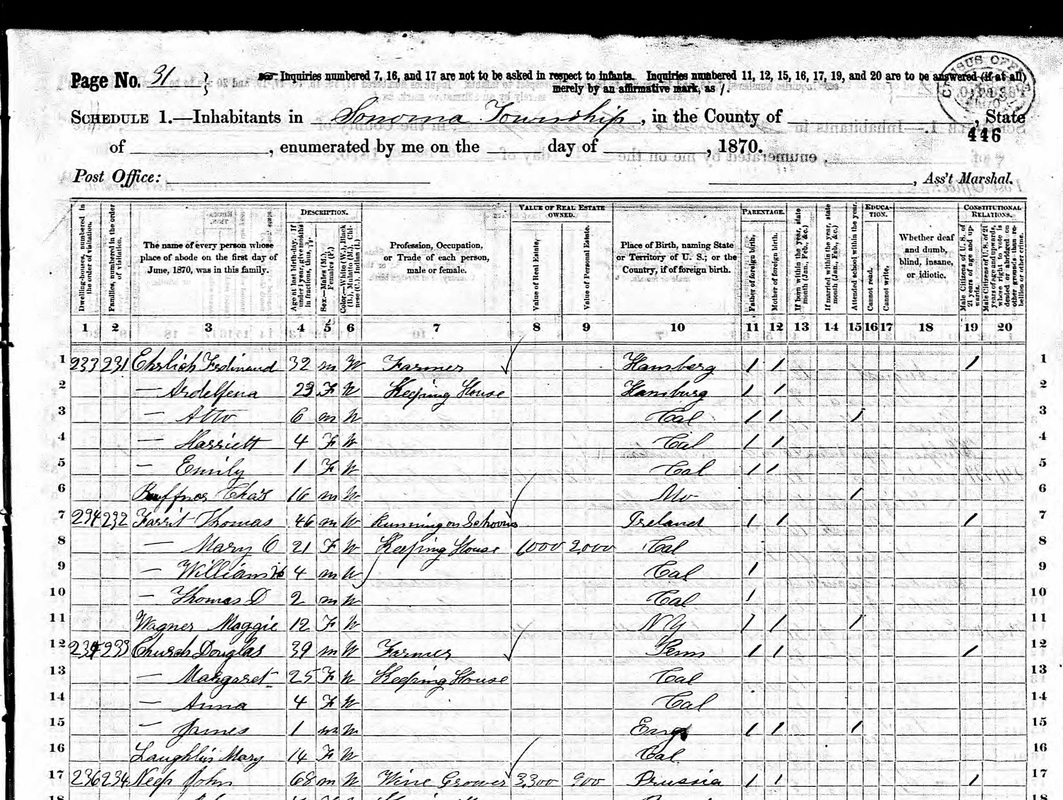 When we are looking at a census image, the tendency is to imagine what we see is the original data the enumerator wrote on the form. But the census we see might just as easily be a copy of the worksheet an enumerator carried door to door as he went on his rounds.[i] And when information is copied from one form to another, the opportunity for errors creeps in. Here is an image from the household of Douglas Church in Sonoma Township, Sonoma County, California. The household, listed on lines 12-16, consists of 5 people. Though the 1870 census does not list relationships, it appears to be a family – head Douglas, wife Margaret, daughter Anna and son James along with a teenage girl, Mary Laughlin, perhaps helping out as a domestic servant.[ii] But as I look closer at the census, something doesn’t make sense. Douglas is born in Pennsylvania and Margaret and Anna are both born in California, but little baby James is born in England. Wow – so in 1869, a family in California packed up, crossed a continent and an ocean to England, had a baby and then decided they didn’t like the climate and returned to California? And if you keep looking at this census, and you might notice how precocious young James Church is as well – he attended school within the year! Back to the copy business… it appears to me that the biographical details attributed to little James – birthplace of England, parents of foreign birth, and attendance at school – belong to the girl listed one line below him, Mary Laughlin. I suspect enumerator Alonzo Walker might have mixed up some of the details when he copied the names and tick marks to another form. I spent a lot of time looking for my great-grandmother’s cousin, Mary Lockren, in Sonoma County in 1870. I was looking for a 14-year-old girl born in England, not one born in California. But when you run out of options, you need to expand your net. I found myself willing to look at a record with an entirely wrong birthplace and I believe I found my girl. And I learned a valuable lesson – don't assume those census copies are ever 100% accurate. [i] Loretto Dennis Szucs and Matthew Wright, Ancestry.com Wiki (https://www.ancestry.com/wiki/index.php?title=Overview_of_the_U.S._Census : accessed 16 August 2016), “Overview of the U.S. Census” [ii] 1. 1870 U.S. census, Sonoma County, California, population schedule, Norfolk, p. 36, dwelling 281, family 233, Douglas and Margaret Church; digital image, Ancestry.com (http://www.ancestry.com : accessed 16 August 2016); citing NARA microfilm publication M593, roll 91. This week has been a little hard. I spent a few days in the hospital for some emergency surgery, which always gets one’s wheels turning about one’s own mortality, and it’s just a few days before the eighth anniversary of my father’s death, and the 48th anniversary of his mother’s death. My post today is an email I sent to friends and family eight years ago, the day after Dad passed away. Miss you, Dad.
Hi All, I just wanted to let you know my Dad passed away last night. Please keep him and us in your prayers. I had visited him last week. I was here from Tuesday August 5 to Monday August 11. Dad was struggling but still doing most things by himself. The day I left, he had gotten up, gotten himself dressed and gone from his bed to the couch in the living room and was sitting there when I awoke at 6:45 and brought him the newspapers – The Wall Street Journal, San Francisco Chronicle, Vallejo Times-Herald, and the Benicia Herald. National to regional to area to small town. He read them all every day. I kissed him goodbye before I left at 7:15 to catch my plane back to Seattle. I told him I would be back on the 19th to see him. I talked to my brother, David, that afternoon when I got back to Seattle and Dad was doing OK. He had gone back to bed about 2:30 and was resting when I called. About 4 Dad asked David if he would get a priest to come sometime in the next few days. David asked, “If I could get someone here today, would you want that?” and Dad’s answer was an emphatic “Yes.” The priest came and recognized that Dad was in a great deal of pain and said we should get hospice in to get him some relief. He also brought communion for Dad. Hospice came Tuesday, did an assessment, and Wednesday they brought in a hospital bed that they put in the living room, right at Dad’s favorite spot where he could look at his beautiful view over the Carquinez Strait and watch the ships go up and down and the trains on the other side of the water go back and forth. Hospice also brought some medication for the pain. My brother, Dick, arrived from Houston Thursday night, a trip he had been planning for a few weeks. Friday morning the hospice nurse came and said Dad did not look well at all. When my brother called be about 10:15, Mark and the kids and I were just outside of Baker City, Oregon, about six hours from Seattle, where I was learning to drive a steam locomotive. I had been planning this trip and talking to Dad about it for a long time. Dad was a huge rail fan ant this was something I so wanted to share with him. We finished our train adventure and drove all the way back to Seattle. I unpacked and repacked, got a few hours’ sleep, and got on a 7:30 am Saturday flight to California. I was here by 10:45. Dad was alert enough in the afternoon to want to watch some TV and I was able to show him some video and pictures of the train adventure. (While I was sleeping on Friday night, my wonderful husband stayed up all night to put together a DVD of the adventure to play for Dad.) My sister, Tori, had flown in Friday night, and my sister, Diane, arrived about dinner time on Saturday. Dad was pretty uncomfortable Saturday evening and settled into a fitful sleep. He was continually reaching his hand out, and appeared to be grasping someone’s hand. He called for John (I’m not sure which John) and said things like “I’ll be there.” Dick and I sat with him. I prayed many Hail Marys and also prayed to my Grandma Kircher, Dad’s mom, to come get her boy. The date, August 16, 2008, was the 40th anniversary of Grandma Kircher’s death. I went to bed about 10:15. I heard Tori get up a few minutes later, and about 10:45 Dick woke me and told me that Dad had passed. He put up a good fight, but he was ready to go. He missed my mom and my stepmother so much. I’m glad that we were able to keep him here in the house he loved and that we were all able to be here with him. Thank you for all your support during this time. Mary My father was a great one for clipping things out of newspapers. Every time I’d go to visit him there’d be a stack, thoughtfully curated. Something for me about genealogy he’d seen in the San Francisco Chronicle, something for my husband about science education from the Wall Street Journal. And speaking of the WSJ, every Friday he’d cut out the crossword puzzles and save them for me. I’d come home with a sheaf of them, and tuck them in a drawer or in my big book of New York Times Crossword puzzles. I’ve done most of them, but occasionally I’ll find an unsolved one and it’s like a little gift from Dad, eight years since his passing. One of the most precious newspaper clippings, however, didn’t come from Dad, it came from Mom. When I was about ten, she was diagnosed with uterine cancer. The surgeon who performed the hysterectomy thought he got it all, but what did doctors really know about cancer in 1970? Apparently not enough, and a few years later, the cancer came back with a vengeance, riddling her body. For two years, she fought the good fight, trying to beat her foe with round after round of chemotherapy, the most unfriendly of allies. At some point Mom knew what was coming. And she knew she would not be there for her husband and children to hold our hands and wipe our tears, to give a hug and tell us we’d be okay, we’d get through it. Mom had experienced this kind of loss before, having buried both her parents and her first husband. I’m sure she remembered how hard those first few days and weeks are, the time you most need the support of your mother or spouse, as you struggle to make sense of the hole in your life. So Mom clipped a poem out of the newspaper and tucked it in her purse for Dad to find, something she thought might give voice to the words she would not be able to say. Shortly after her death on April 3, 1977, my dad found the clipping, and made a lovely tribute to Mom of it, a framed piece with her picture and the poem. I think all of my siblings still have our copies framed in our homes. I treasure mine. Recently I ran across a box of Dad’s things, and in it was that original clipping Mom tore out of the paper, jaggedy edges and all. I’ve often wondered - just when did Mom see that poem and know it would be needed? Days before her death? Weeks? Months? As I sit her in 2016, 39 years after she died, and just a few days before what would be her 94th birthday, the detective in me came out. I spent some time with the clipping, with the few words of the editorial on the back side of the scrap of yellowing paper, and with a digital newspaper database, searching for the issue. I found my answer. Three months. She knew, even if we didn’t. December 30, 1976, Mom tore out the clipping, knowing that the moment so eloquently described by Emily Dickinson would come to pass in her own home before too long. And she left us something to help us get through it. The bustle in a house The morning after death Is the solemnest of industries Enacted upon earth – The sweeping up the heart, And putting love away We shall not want to use again Until eternity.[i] [i] “The Bustle in a House” by Emily Dickinson 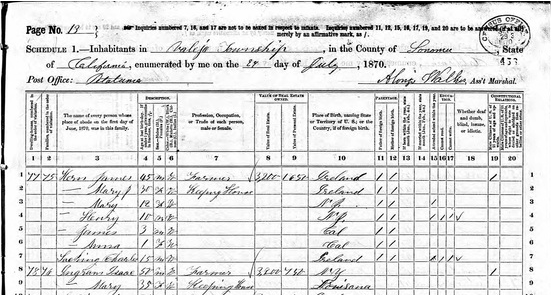 1870 US Federal Census, Vallejo, Sonoma, California, Jame Hern family 1870 US Federal Census, Vallejo, Sonoma, California, Jame Hern family This morning, genealogist Lisa Talbot Lisson presented a Facebook Live talk about using timelines. She had some great points about this helpful tool and inspired me to blog about timelines today. Timelines have been helpful in my research over the years. For instance I could not find my great-great grandparents, James and Jane Ahern on the 1870 census. I had an idea that they were either in San Francisco or Sonoma County, but no amount of searching would turn them up. But then I created a timeline and noticed that they had daughters baptized at St. Vincent’s Catholic Church in Petaluma, Sonoma County in 1869 and 1871.[1] The timeline showed me quite clearly I should definitely be looking for them in the Petaluma area in 1870. Armed with this new insight, I did a search for every man named James who was born in Ireland sometime between 1825 and 1835 and lived in Sonoma County. I probably had 50 men or so who fit this broad description, and as I scrolled through the list, I could easily eliminate some just by the surname – Biggins and Craddock were not likely misrepresentations of the surname I sought. But once I got down to the H’s, there I found James Hern,[2] exactly the man I was looking for! His naturalization records, voter registrations and other documents refer to him as “Ahern” but I suppose the census enumerator just misheard the name and called him Hern. And Jane? She’s Mary J on the census. Timelines can help with research in so many ways. James and Jane Ahern didn’t were hiding from me in 1870, but once I narrowed down their hiding places with a timeline, I didn’t have to look too long to find them. Try making a timeline of your ancestor’s life. It might help you to find some missing records. I’ll be presenting “Using Timelines to Understand Your Ancestors” at the Kelowna and District’s Harvest Your Family Tree Conference, September 23-25, 2016. If you’d like to learn more about timelines and how they can help in your research, come join me! [1] Ahern, Sarah A, baptismal record, 22 May 1869, St. Vincent de Paul Church, Petaluma, Sonoma, California. Photocopy of page from unidentified register. Ahern, J.I,, baptismal record 20 Oct 1871, St. Vincent de Paul Church, Petaluma, Sonoma, California. Photocopy of page 128 from unidentified register. Note: Additional writing in margin which appear to have been written later in a different pen and by a different person indicates “John” but John Cornelius Ahern was born in 1873, and Jane Isabella/Isabel “Belle” Ahern was born in 1871. It is my opinion the notation of "John" in the register is incorrect. [2] Hern, James, 1870 U.S. Census population schedule, Year: 1870; Census Place: Vallejo, Sonoma, California; Roll: M593_91; Page: 456A; Image: 87186; Family History Library Film: 545590 |
AuthorMary Kircher Roddy is a genealogist, writer and lecturer, always looking for the story. Her blog is a combination of the stories she has found and the tools she used to find them. Archives
April 2021
Categories
All
|
